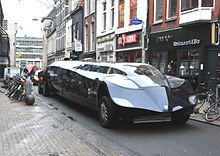Superbus (transport)
This article needs additional citations for verification. (January 2013) |

The Superbus is a prototype high speed electric coach that is capable of carrying 23 passengers at speeds of up to 250 kilometres per hour (160 mph) on specially designed segregated highway lanes.[1] The Superbus project, led by Dutch astronaut professor Wubbo Ockels of the Delft University of Technology until his death in 2014 envisages a comfortable, demand-dependent door-to-door transportation rivaling the car and the train. The project, which encompass infrastructure, logistics, safety, reliability and economic viability, in addition to the design of the vehicle itself, has received funding of €7 million, largely provided by the Dutch State.
The vehicle

The vehicle is a 15-meter-long electric vehicle with seating for 23 passengers accessible from 16 doors with a cruising speed of 250 kilometres per hour (160 mph) and a range of 215 kilometres (134 mi).
Super lanes
It is envisaged that the vehicle will run on special 'Super Lanes' which will be geothermically heated in order to prevent icing in the winter season.
Logistics
Rather than following a timetable the vehicle will be routed in response to the needs of the particular passengers offering a complete journey without changes based on central routing optimization system.
